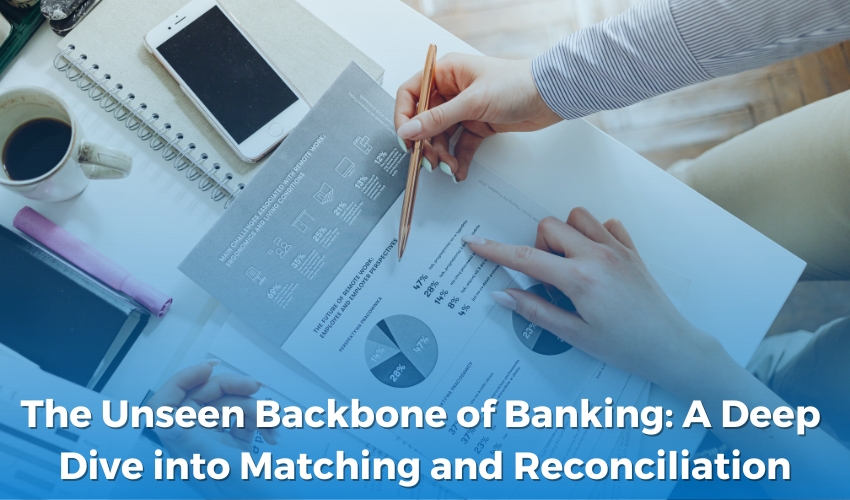

11-01-24
In the world of banking, where transactions flow seamlessly, there is a critical and often overlooked process that forms the backbone of financial operations: matching and reconciliation. While the term might not ring a bell for many, this behind-the-scenes hero plays a pivotal role in ensuring the accuracy, transparency, and efficiency of banking activities. Let's embark on a deep dive into the fascinating world of matching and reconciliation and understand why it is the unsung hero of the banking realm.
Understanding Matching and Reconciliation
Matching and reconciliation are two intertwined processes that involve comparing different sets of financial data to ensure they align correctly. In simpler terms, it's like putting together a financial puzzle, making sure all the pieces fit perfectly. These processes are crucial for banks to maintain accurate records, comply with regulations, and identify discrepancies or errors in transactions.
Transaction Matching
Transaction Matching involves comparing data from different sources to confirm that they correspond accurately. In banking, this primarily refers to reconciling transactions between the bank's records and those of its customers or other financial institutions. This can include matching payment orders, invoices, or any other financial documents to verify that the transaction details match on both ends.
Automated matching systems have become indispensable in modern banking, using algorithms to quickly and accurately compare vast amounts of data. This not only speeds up the process but also minimizes the margin for human error.
Reconciliation
Reconciliation takes the process a step further by identifying and resolving discrepancies between the matched data. This could involve investigating the reasons behind discrepancies, rectifying errors, and ensuring that the financial records are in harmony.
One of the common scenarios where reconciliation is crucial is in the case of bank statements and general ledgers. Reconciliation ensures that the bank's internal records align with external statements, offering a clear and accurate financial picture.
The Significance of Matching and Reconciliation:
Error Detection and Prevention:
Matching and reconciliation services as robust mechanisms for detecting errors early in the financial process. Whether it's a data entry mistake, a system glitch, or a deliberate attempt at fraud, these processes act as the first line of defense, ensuring that discrepancies are identified and addressed promptly.
Regulatory Compliance:
The financial sector is governed by a myriad of regulations and compliance standards. Matching and reconciliation play a pivotal role in ensuring that banks adhere to these regulations. By maintaining accurate and transparent records, banks can easily demonstrate their compliance during audits and regulatory scrutiny.
Operational Efficiency:
Imagine a scenario where a bank's records don't match with the customer's statements or with those of other financial institutions. The result would be chaos, leading to customer dissatisfaction, financial losses, and reputational damage. Matching and reconciliation streamline operations, minimizing the risk of such discrepancies and ensuring a smooth, efficient banking experience for all stakeholders.
Fraud Detection:
Fraudsters are becoming increasingly sophisticated, attempting to exploit any vulnerabilities in the financial system. Matching and Reconciliation act as a powerful tools in detecting anomalies that may be indicative of fraudulent activities. By identifying irregular patterns or unauthorized transactions, banks can take swift action to mitigate potential risks.
Enhancing Decision-Making:
Accurate and up-to-date financial data is crucial for informed decision-making within the banking sector. Matching and reconciliation provider the foundation for reliable financial reporting, allowing banks to make strategic decisions based on a solid understanding of their financial position.
Challenges in Matching and Reconciliation:
While the importance of matching and reconciliation cannot be overstated, it comes with its set of challenges. The sheer volume of transactions, the diversity of financial instruments, and the complexity of modern banking systems make the process intricate and time-consuming. Additionally, manual reconciliation processes are prone to errors, emphasizing the need for sophisticated automated systems.
The Future of Matching and Reconciliation:
As technology continues to advance, the future of matching and reconciliation in banking looks promising. Artificial intelligence (AI) and machine learning (ML) are increasingly being integrated into banking operations, offering the potential to automate and enhance the matching and reconciliation processes further.
Advanced algorithms can analyze patterns, learn from historical data, and adapt to evolving transaction structures. This not only speeds up the matching process but also improves accuracy and reduces the need for manual intervention.
Conclusion
In the dynamic and fast-paced world of banking, the unseen heroes, matching and reconciliation services in the USA, play a crucial role in maintaining the stability and integrity of the financial system. As we delve deeper into the digital age, the evolution of technology promises to revolutionize these processes, making them more efficient, accurate, and indispensable than ever before. It's time to acknowledge and appreciate the unsung backbone of banking, ensuring that the financial world continues to operate seamlessly and securely
Tags : Reconciliation Service Provider,Reconciliation Service in USA,Account Reconciliation Services in USA













































.jpg)
.jpg)
.jpg)
.jpg)


).jpg)














 Get A Quote
Get A Quote
Leave A Comment